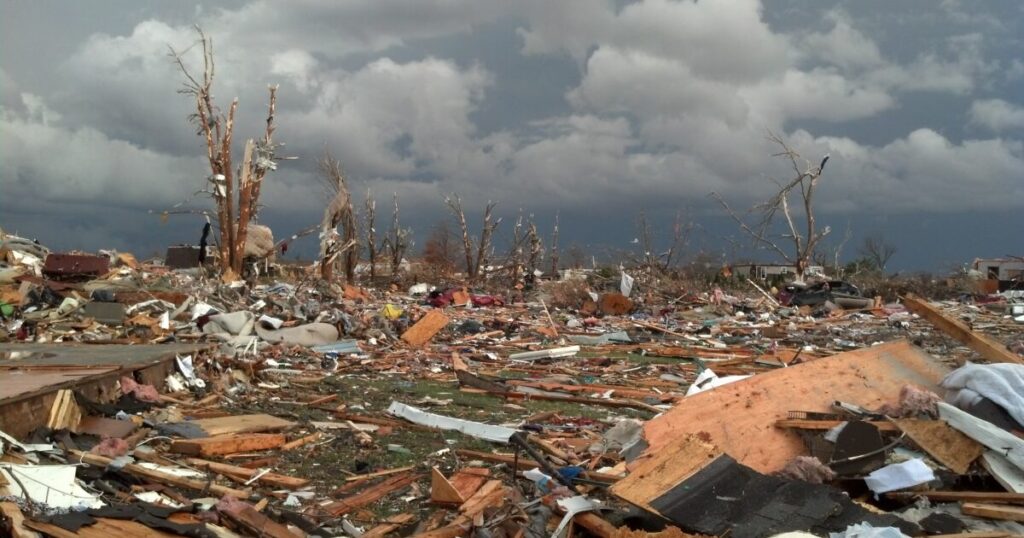One of the indicators that climate alarmists use to push the climate crisis narrative is the increasing cost of storms.
The logic appears straightforward: a storm that did $10 million in damage must be more severe than one that did $1 million in damage, and since storms cost less money in the past, they claim this proves that storms are getting more severe.
They also set dollar thresholds for severe storms, and since more storms exceed this dollar threshold, they claim that severe storms are occurring more frequently.
However, this reasoning fundamentally misunderstands the economic factors driving storm damage costs.
According to data from the National Oceanic and Atmospheric Administration (NOAA), since 1980, there have been 403 billion-dollar weather disasters in the United States, with tropical cyclones causing over $1.5 trillion in total damage.
In 2024 alone, the U.S. experienced 27 billion-dollar disasters resulting in $182.7 billion in damages. Climate activists point to these numbers as evidence of worsening storms, but this analysis reveals a critical flaw in their methodology.
The $1 billion threshold used to classify “severe” storms is fixed and not adjusted for inflation beyond the basic Consumer Price Index.
According to NOAA’s Climate.gov, this flawed approach has resulted in 57 events since 1980 that were originally below the billion-dollar threshold but are now classified as billion-dollar disasters simply due to inflation.
This artificial inflation of severe storm counts creates the false impression that dangerous storms are becoming more frequent when, in reality, the monetary threshold has simply lost its meaning over time.
Inflation has turned million-dollar storms into billion-dollar ones. The effect is clear in historical comparisons. Hurricane Katrina caused $125 billion in damage in 2005—equivalent to $200 billion today, according to WCNC.
Hurricane Harvey’s $125 billion in 2017 would equal about $159 billion in 2024, a $33 billion jump in just seven years. Most striking is the 1926 Great Miami Hurricane, which cost $105 million at the time but would have caused $236 billion in 2018, per the Washington Post.
These examples show how inflation alone can make storms seem far more “severe” over time.
Apart from inflation, another driver behind escalating storm costs is the massive increase in population and development in hurricane-prone areas.
According to research published by The Washington Post, the combined population of the 15 counties hit by Hurricane Milton’s hurricane-force winds grew from 3.7 million people in 1980 to 9.1 million in 2023, more than doubling, while the area’s economic activity quadrupled over the same period.
Data from the Center for Climate and Energy Solutions shows that there are nearly 50 million homes and at least $1.4 trillion in assets within an eighth of a mile of the coast, with U.S. coastal populations growing by roughly 35 million people between 1970 and 2010.
When hurricanes strike these increasingly populated and developed areas, the damage costs naturally skyrocket regardless of the storm’s actual intensity.
When researchers account for population growth, development, and inflation, the apparent trend in storm severity vanishes.
A study in Nature Sustainability, cited by The Washington Post, found that once hurricane damage is adjusted for increases in people and property, the rising destruction trend disappears.
Similarly, research in the Bulletin of the American Meteorological Society shows no significant trend in normalized U.S. hurricane losses since 1900. As the researchers noted, this is expected, landfalling hurricanes have not increased in frequency or intensity from 1900 to 2017.
Contrary to climate activist claims, actual storm frequency data reveals no significant increase in severe weather events.
According to the Environmental Protection Agency’s Climate Change Indicators, since 1878, approximately six to seven hurricanes have formed in the North Atlantic every year, with roughly two per year making landfall in the United States.
The total number of hurricanes and the number reaching the United States show no clear overall trend since 1878.
This finding is supported by peer-reviewed research published in Nature Communications, which found that “recorded century-scale increases in Atlantic hurricane and major hurricane frequency are consistent with changes in observing practices and not likely a true climate trend.”
The study concluded that apparent increases in storm frequency are better explained by improved detection and reporting methods rather than actual changes in storm patterns.
When they claim severe storms are becoming more frequent, what they mean is that more storms now exceed an arbitrary damage threshold, resulting from more people with more expensive homes and more possessions living in storm-prone areas.
Rather than a climate crisis, it seems more like a matter of personal choice, and perhaps questionable judgment.
Read the full article here
